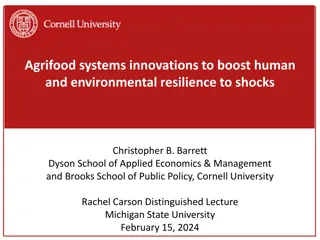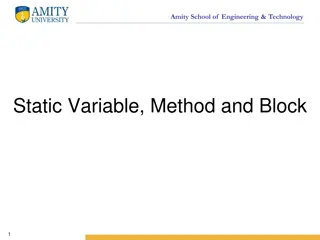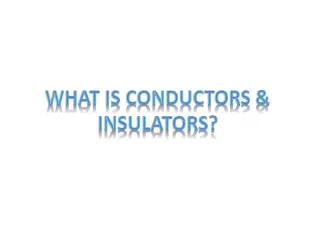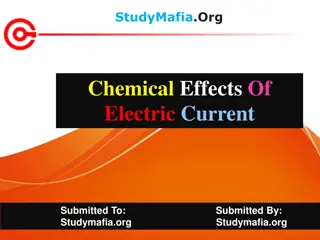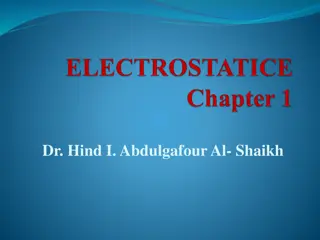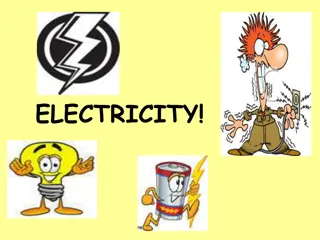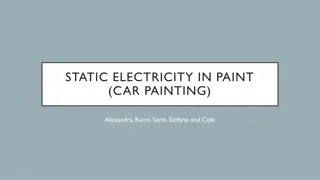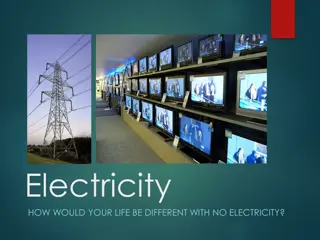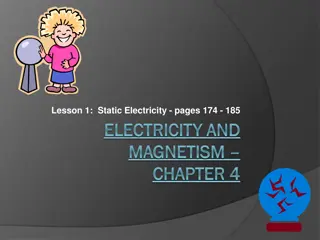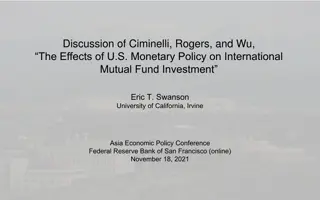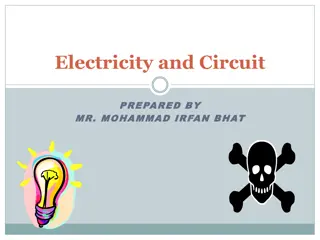Understanding Electricity: From Static Shocks to Conductors
Delve into the world of electricity, demystifying phenomena like static shocks, sticky socks in dryers, and the science behind lightning and auroras. Explore the properties of charge in atoms, electric forces, Coulomb's Law, conductors vs. non-conductors, and more. Gain insights into volts, amps, ohms, GFCIs, and energy-efficient lighting options like compact fluorescent lights.
Uploaded on Oct 11, 2024 | 0 Views
Download Presentation

Please find below an Image/Link to download the presentation.
The content on the website is provided AS IS for your information and personal use only. It may not be sold, licensed, or shared on other websites without obtaining consent from the author. Download presentation by click this link. If you encounter any issues during the download, it is possible that the publisher has removed the file from their server.
E N D
Presentation Transcript
L 23 Electricity & Magnetism [1] Static electricity Why do I get a shock when I walk across the rug and touch the door knob? Why do socks stick to my shirts in the dryer? Why does my hair stick to my comb? What is lightning? What produces the aurora? What are volts, amps and ohms? What are GFICs (special electrical outlets in the bathroom) Are compact fluorescent lights more efficient? We will discuss the basic aspects of electricity that will hopefully remove some of the mystery and fear surrounding it. 1
Its the CHARGE! we know that matter has MASS but . . . it also has CHARGE! the mass is what gives the gravitational force the charge is what gives us Electrical forces We don t directly see the effects of charge because the charge is bound inside of atoms Nitrogen Atom 2
What is in atoms? charge is just another property like mass Atoms have a nucleus at its center and a electrons that move around it The nucleus: two kinds of heavy particles neutrons have no charge protons have a positive charge Two kinds of charge: positive and negative Electrons and protons have the same magnitude of charge but electrons are and protons are + The mass of the proton is about 2000 times the mass of the electron 3
Electric forces charges exert electric forces on other charges two positive charges repel each other two negative charges repel each other a positive and negative charge attract each other + + + The repulsive electric force between 2 protons is 1039 times stronger than the attractive gravitational force! 4
How Strong is the Electric Force between two charges? Coulomb s Law It depends on how big the charges are, and how close they are The bigger the charges, the bigger the force The closer the charges, the bigger the force This is known as Coulomb s Law The unit of charge is the Coulomb (C) Q Q e= 1 r 2 F k e 2 Q2 Q1 r 5
Conductors and Non- Conductors Metals (copper, aluminum, iron) are conductors of electricity that means that charge can move through them Plastics, wood, ceramics, and glass are non- conductors (or insulators) they do not let electricity flow through them You should not stick a metal fork into an electrical outlet! You could stick a plastic fork into an outlet without electrocuting yourself Please do not do this! 6
What makes conductors conduct? Atoms have equal numbers of positive and negative charges, so that a piece of material usually has no net charge the plusses and minuses cancel each other. However, when you put many metal atoms (like copper) together an amazing thing happens one electron from each atom forgets which atom it belongs to. All the homeless electrons are free to wander about inside the material. 7
Current charges moving around If I connect a battery to the ends of the copper bar the electrons in the copper will be pulled toward the positive side of the battery and will flow around and around. this is called current flow of charge Free electron copper An electric circuit! Duracell 8 +
Seeing and hearing electricity! The capacitor keeps charging until it reaches its limit. Charge storage device Capacitor Many Batteries 9
Fully loaded and ready to go! The sudden discharging of the capacitor is accompanied with a big spark and a bang man-made lightning! A spark occurs when there is enough energy released to cause the electrons in the air molecules to be ripped out of the molecules ionization danger fully charged 10
Danger High Voltage ! The van de Graff can charge the sphere to more than 50,000 volts! This is enough to cause discharges to the surrounding air ionization or breakdown The sparks excite air molecules which give off visible light 11
Making Sparks: The Van de Graff Generator The van de Graff generator is a device for building up a large electrical charge on a metal sphere The charge is generated by friction between a conveyor belt rubbing a charged comb The charged belt transfers the charge to the collecting comb attached to the metal sphere. 12
Both conductors and non-conductors can be charged! Even though non-conductors do not have free electrons wandering about, they can be charged by friction When you move your comb through your hair, the friction (rubbing) between the comb and hair can pull some of the electrons out of your hair and onto the comb as a result your comb ends up with a net negative charge and attracts your hair which is now positive. 13
Charging by friction - triboelectricity If you rub plastic with fur (e.g. cat or rabbit), electrons are rubbed onto the plastic making it negative if you rub glass with silk, electrons are rubbed off the glass making it positive the charge can be transferred to other objects. 14
The charging process an object is charged positive (has a net positive charge ) if electrons are removed from it an object is charged negative (has a net negative charge) if electrons are transferred to it charges can be transferred from conductors or non-conductors but they can only move through conductors. Charge is conserved in the transfer of charge the charge is merely passed from one object to another, no charge is lost in this process. 15
Attracting uncharged objects + + + A negatively charged rod will push the electrons to the far side leaving the near side positive. The force is attractive because the positive charges are closer to the rod than the negative charges + uncharged metal sphere 16
You can bend water with charge! The water molecule has a positive end and a negative end. charged rod When a negative rod is brought near the stream of water, all the positive ends of the water mole- cules turn to the right and are attracted to the negative rod. 17 stream of water
The Magic Wand Wooden board We can make the board move with electric forces 18
Can attract nonconductors also Even though nonconductors do not have free electrons that can move around, the molecules can be polarized the positive and negative charges can be separated slightly ++ + ++ + + + 19
One Coulomb is a HUGE charge To get a charge of one Coulomb on an object we would have to remove 6.250 x 1018 electrons from it! In the capacitor discharge demonstration, only 1/100 of a Coulomb was involved. 20
Seeing the effects of charge: the electroscope the electroscope is a simple device for observing the presence of electric charge it consists of a small piece of metal foil (gold if possible) suspended from a rod with a metal ball at its top If a negatively charged rod is placed near the ball, the electrons move away because of the repulsion. The two sides of the metal foil then separate. 21
Electric Potential voltage The amount of charge on a charged sphere can be measured in terms of its electric potential or voltage The more charge that is on the sphere, the higher its voltage or electric potential measured in VOLTS If I connect a battery to the sphere, it pulls the negative electrons from the sphere and deposits them to the ground, thus leaving the sphere with a net positive charge. + battery Earth 22




